Asus Eee Slate EP121 Review
Asus Eee Slate EP121
This 12.1in Windows 7 tablet packs in both capacitive and Wacom pen touch-sensing, making for the ultimate portable doodling tool.

Verdict
Pros
- Large IPS screen with Gorilla glass
- Powerful and fast, excellent connectivity
- Capacitive or stylus interaction
- Windows 7 offers superb productivity potential
- Premium wireless keyboard
Cons
- Very expensive
- Windows 7 not designed for touch or tablets
- Poor battery life
- No 3G
- Too large and heavy to hold one-handed
Key Specifications
- Review Price: £997.92
- 12.1in 1,280 x 800 IPS display, Gorilla Glass
- Intel Core i5-470UM, 4GB RAM, 64GB SSD
- Capacitive screen, Wacom digitizer with stylus
- USB 2.0 and mini-HDMI, Bluetooth
- Windows 7 Home Premium 64-bit
As the tablet wars rage on, the iPad 2 is still one of the slickest tablet experiences around, while Windows 7
is generally regarded as the worst. That’s hardly surprising, since Microsoft’s
OS wasn’t primarily designed for either tablets or touch. Unfortunately, sub-par
implementations on Windows tablets like the Acer Iconia Tab and MSI WindPad 100W didn’t do it any favours. However, since Asus has produced
one of the best Android tablets available today with its award-winning Eee Pad Transformer, we have high hopes for its Eee Slate EP121.
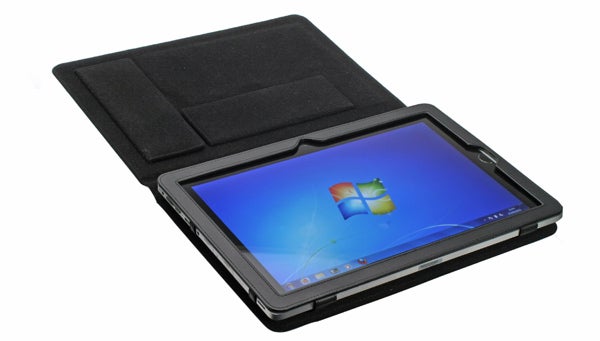
The Eee Slate takes a slightly left-field approach to the
tablet market, in that it goes for the biggest and best of everything, a fact
that’s reflected in its £997 asking price. Where most of the competition offers
tablets of around 10 inches or less, the Slate’s screen is a relatively huge 12.1in –
and with an IPS panel protected by Gorilla glass it’s as good as it gets. Where
rivals contain underpowered Atom processors and max out at 2GB of RAM, the
Slate rocks on with a full fat mobile Core i5 and 4GB of RAM. Combined with a
64GB SSD, it offers more power than many budget desktops, allowing for
effortless productivity and multi-tasking.
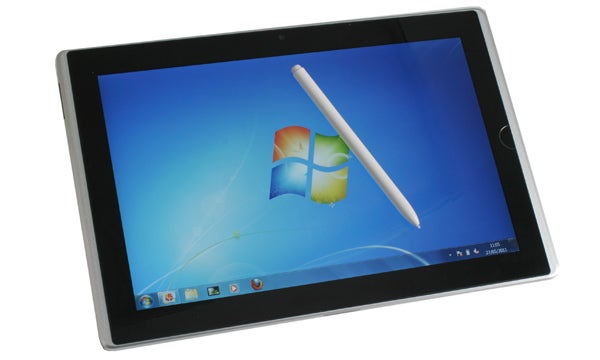
For artists, designers or just those fond of handwriting,
the integrated Wacom Digitizer with included stylus is a dream come true, and
for regular finger interaction the screen offers capacitive touch too. And finally
there’s the bundled wireless Bluetooth keyboard. Rather than an average
first-party keyboard, Asus has made the laudable decision of going with the
Microsoft Bluetooth Mobile Keyboard 6000, which takes typing comfort to a
whole new level.
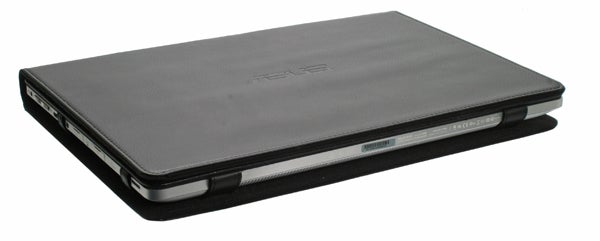
Unfortunately, the included case doesn’t really keep up the premium impression. Though it’s well-made with a sturdy leatherette finish, it
relies on a Velcro strap to hold the tablet in securely and doesn’t offer much
flexibility when trying to stand the tablet up. You only get the choice between
a 30 degree incline in either portrait or landscape orientation. What’s more, it weighs a whopping 376 grams – as much some smaller tablets!
The tablet itself restores our confidence with a seamless
glass front overlaying the black screen bezel, framed by a metal surround. Asus has gone with white plastic for the back, which isn’t the most premium looking material but at least it keeps the weight down, and it’s textured rather than glossy. This prevents fingerprints, decreases wear
marks and provides a better grip.
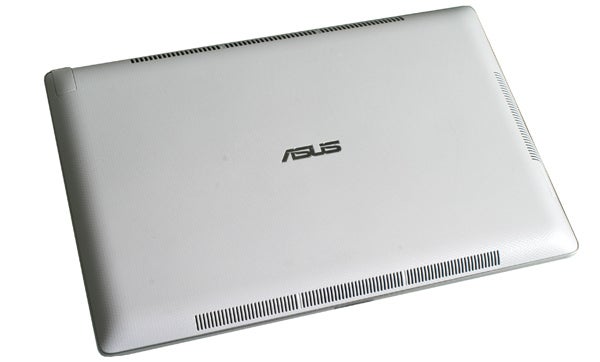
Large ports are hidden behind strong-hinged flaps, buttons
are chromed and build quality is generally excellent with no creak and minimal
flex. Our one minor concern is that putting pressure on the centre of the
tablet’s rear affects the screen. However, with a little care when handling, this shouldn’t
become an issue.
Considering its 312 x 17 x 207mm dimensions and high-power
internals, the Eee Slate is not too heavy at 1.17kg, but it’s certainly not a
tablet you can hold comfortably one-handed for any length of time.
Connectivity on the Eee Slate EP121 is excellent. All of it
can be found along the left side of the tablet, where you’ll discover a mini-HDMI
port, combined headphone and microphone jack, SDHC-XC/MMC memory card reader and twin
full-size USB 2.0 ports hidden behind sturdy flaps on flexible hinges. This
makes it easy to hook the tablet up to a TV for playing back Full HD video, or
to connect a monitor and mouse which, along with the keyboard, gives a full
desktop experience. There’s also a front-facing 2 megapixel webcam, though none
at the rear.
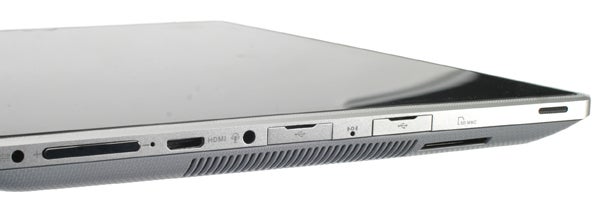
On the wireless front, meanwhile, there are both Bluetooth
and Wi-Fi N, though unfortunately there’s no physical switch to turn these on
or off – a small yet annoying oversight on Asus’ part. A more serious issue is
the Slate’s lack of 3G, which you would expect to be included on a tablet
costing nearly £1,000.

On the other hand, the tablet’s internal specifications do
help to justify that price a little. The highlight, of course, is an Intel Core
i5-470UM processor. This dual-core CPU runs at 1.33GHz as standard, with a
maximum Turbo Frequency of 1.86GHz. It also supports Hyper Threading for up to
four virtual cores. As it’s a low voltage model, it sucks down only 18W, which
is very frugal for such a powerful CPU but more than double the 8.5W demanded
by a dual-core Atom.
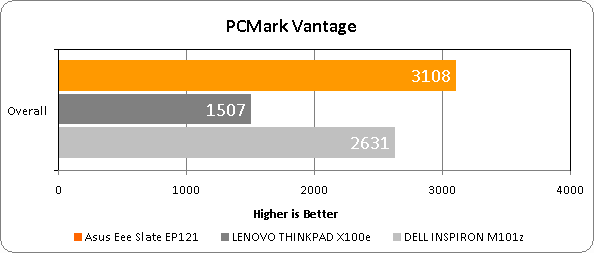
It’s backed by 4GB of DDR3 RAM, an almost unheard of amount
for a tablet and plenty for high-intensity productivity and demanding
applications. For storage, meanwhile, there’s a 64GB SSD, of which around 32GB
is left free by the Windows 7 install. This should be adequate if you keep your
application and video count frugal, and don’t forget that you can expand the
tablet’s storage by up to 128GB (and more as larger SDXC cards become available) using its memory card slot.
Only the graphics card is a disappointment. It’s Intel’s
older generation integrated effort, meaning even a relatively undemanding 3D
title like Stalker will run at a frame rate of single digits. However, it’s
adequate for casual gaming.
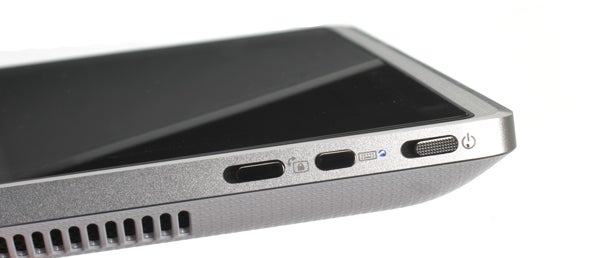
Thanks to these laptop-like specifications, the 64-bit
edition of Windows 7 Home Premium is a perfectly smooth experience on the Eee
Slate EP121. In fact, this is the first Windows tablet we’ve come across where
the OS doesn’t feel like a burden, and where you can load applications and keep
multiple windows open while playing HD video, all without feeling constrained
by the hardware.
A handy dedicated button – the only one on the tablet’s
front – gives access to Windows Flip 3D with a short press, or to the Windows
Security screen (from which you can access Task Manager) with a longer one.
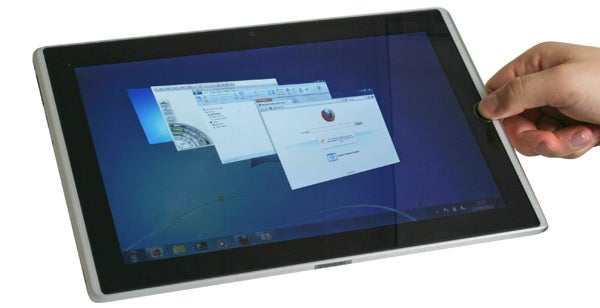
An orientation sensor ensures the screen will match the way
you’re holding the tablet. If you want to keep it the same there’s a handy
orientation-lock switch, an essential but oft-neglected addition to any tablet.
Asus’ premium tablet isn’t just impressive on the inside. As
with its Eee Pad Transformer, the company has wisely gone with an IPS panel for the
12.1in screen. Until larger versions of the AMOLED display used on the stunning
Samsung Galaxy S II come along, this is as good as it gets.

Viewing angles are flawless, colours vibrant yet accurate
and blacks deep and detailed. Along with the unmatched codec and container
support offered by Windows, the large, 1,280 x 800 screen allows you to enjoy
720p video material in all its glory. This is something the iPad 2 can’t claim because of its lower 1,024 x 768 screen resolution, while
Android tablets like the Eee Pad Transformer are hindered by a poor selection of media players.
The
only caveat is that the Gorilla glass layer does cause reflections, but this is
the price you pay for the added protection, and a glossy screen finish is
common to most tablets.
Considering the Slate’s speakers are tiny, the sound they
produce is undeniably impressive, especially since they do so without
distortion. There’s more depth, bass and detail then you would get from many
netbooks, and though headphones are still recommended, they’re certainly not
required.
We’re glad to report that the Slate’s capacitive screen is
as responsive as you could wish, and its larger-than-usual size also helps to
make navigating with your digits a more pleasant experience than on many rival
Windows tablets. However, the fact remains that Microsoft’s OS isn’t particularly
touch-friendly to begin with. Therefore, it’s actually much easier to navigate
using the included stylus, which is stored in a nifty spring-loaded compartment at the tablet’s rear.

Wacom’s built-in digitizer means the stylus doesn’t require
batteries, as it uses magnetic resonance to detect the pen’s position and
pressure level. The pen itself features a replaceable tip at its base and a
rounded eraser at its top. Though it’s a plain white plastic affair, we prefer
the feel of it to the more aesthetically pleasing effort that accompanied the
Lenovo ThinkPad X220 Tablet.
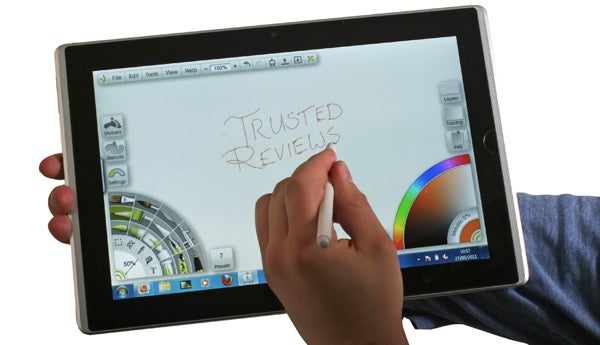
For handwriting it works flawlessly. However, as an artist’s
tool it’s not without its limitations. For one thing, drawing on the Gorilla
glass surface does take some getting used to, especially if you’re used to the
paper-like feel of a proper Wacom Intuos 4. It also lacks the tilt sensitivity of dedicated tablets, and
only registers 512 pressure levels compared to the Intuos 4’s 2048.

On the other hand, being able to draw directly on the screen
holds an undeniable appeal. To get a similar experience with a ‘proper’
graphics tablet, the only option right now is the 12.1in Wacom Cintiq, which
will still set you back around £700 on its own. Much like the £1,380 X220
Tablet then, Asus’ Eee Slate EP121 is a flawed but nonetheless appealing
proposition for artists and designers.

Getting to typing on this tablet, again it’s made easier by
the screen’s larger size, and we appreciate the inclusion of a handy dedicated
button to bring up Windows’ built-in touch keyboard. However, quite simply we
prefer the onscreen keyboards of every other OS but windows. So if you’re
planning an extended typing session, the included Microsoft Bluetooth Mobile Keyboard 6000 is a godsend.
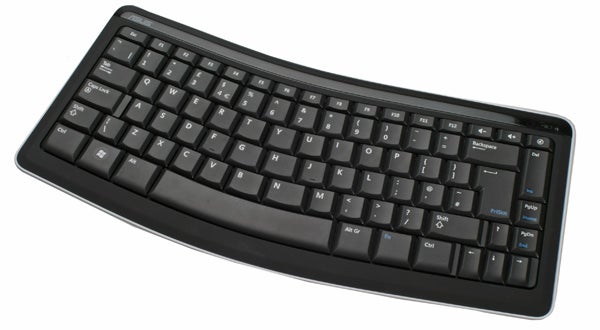
To get the full low down on this award-winning little
keyboard you should click through to read our review, but suffice it to say that
it’s compact and light yet very ergonomic. It offers a superb typing experience
that we doubt any of the keyboard docks for competing tablets can hold a candle
to.
So far then, the Eee Slate EP121 has been holding up very
well indeed. It’s nicely designed, fairly well-built, comfortable to hold and
well-connected, with a superb screen and impressive speakers by tablet
standards. Its responsiveness, large display, stylus ‘pointer’ and excellent
wireless keyboard combined with meaty specifications make it easily the most
usable Windows 7 tablet we’ve seen, and it runs quietly even when under load,
something the MSI WindPad 100W couldn’t even manage with an Atom running at its core.

However, the Slate pays the price for its powerful
components in battery life. During average use with the screen at full
brightness we managed just under three hours, while playing back a looped video
at 50 percent screen brightness and with wireless radios disabled still netted
us only three hours and ten minutes. That’s poor by any standard, but
especially grim when compared to the nine hours and more you would get from an
Android or IOS tablet.
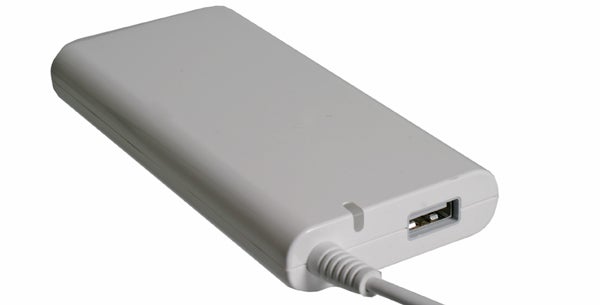
When you get right down to it, however, that’s not a completely
fair comparison. If you want a multimedia and browsing tablet that can also do
light productivity, the iPad 2 and Eee Pad Transformer will serve you well. But if you want the ability to run
the same software as on your laptop or desktop, Windows is the only way to go -
and frankly, this is the first tablet on which Microsoft’s OS feels truly
usable.

Unfortunately, the next hurdle is price. At a whopping £998,
the Slate is far from a value proposition, especially compared to the £400 iPad
2 or £380 Transformer. On the other hand, if you look at it as a designer tool
and compare to an alternative like the £700 Wacom Cintiq, it suddenly seems
like a far more reasonable proposition.
Verdict
Asus’ Eee Slate EP121 is a unique Windows tablet that has a
lot going for it. A beautiful 12.1in IPS screen offers both capacitive and pen
feedback with the included Wacom stylus, making it an intriguing artist’s and
designer’s tool. Powerful internals ensure Windows 7 rarely feels less than
smooth, while comprehensive connectivity and surprisingly good speakers are the
icing on the cake.
However, poor battery life and its incredibly high price
limits the Slate’s appeal to a niche audience of well-heeled,
productivity-oriented individuals who don’t need to stray too far from a power
outlet.
How we test tablets
We test every tablet we review thoroughly. We use industry standard tests to compare features properly and we use the tablet as our main device over the review period. We’ll always tell you what we find and we never, ever, accept money to review a product.
Trusted Score
Score in detail
-
Performance 9
-
Value 6
-
Design 8
-
Features 9
-
Battery Life 4
Other
| Processor | Core i5 |
| Memory (RAM) (Gigabyte) | 4GB |
Display
| Operating System | Windows 7 |

